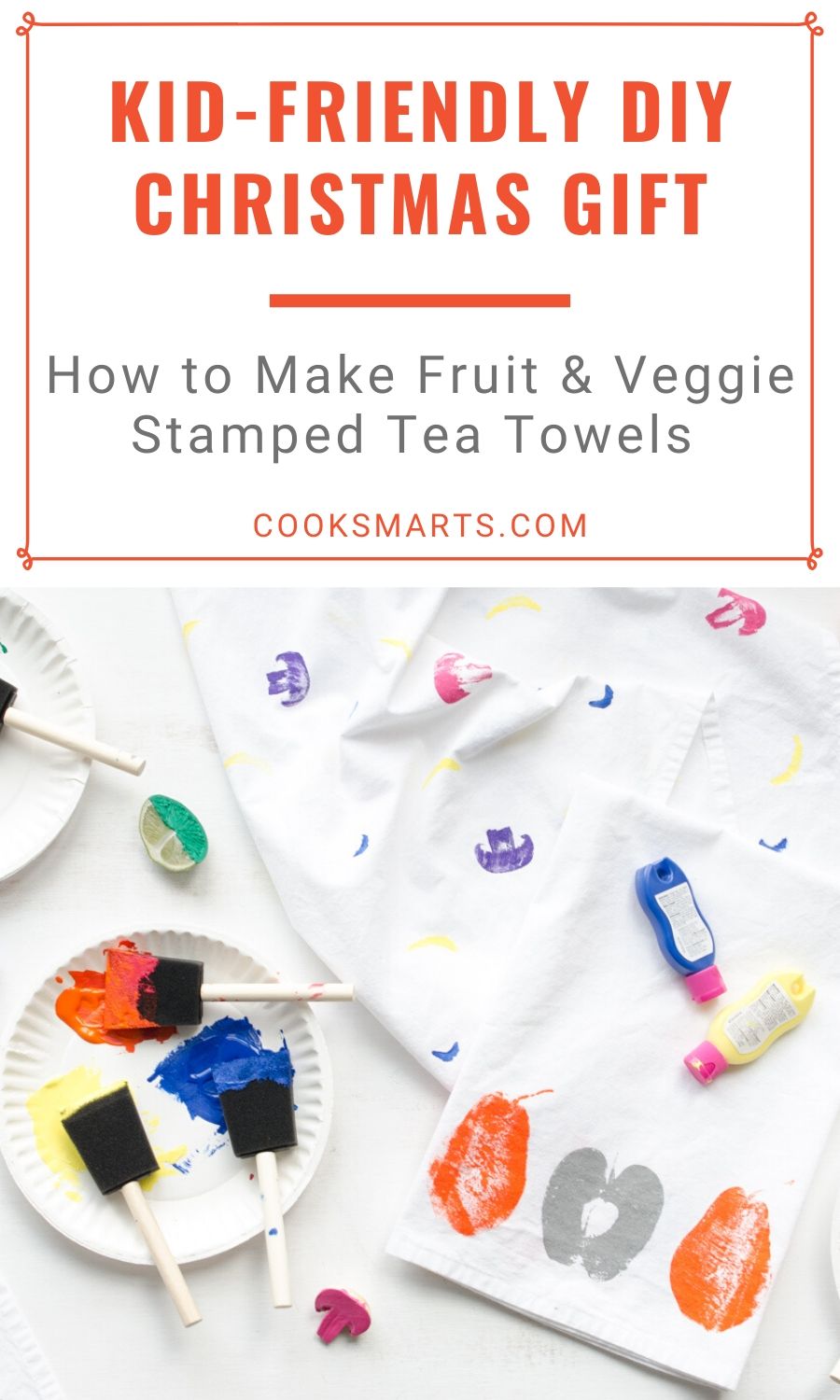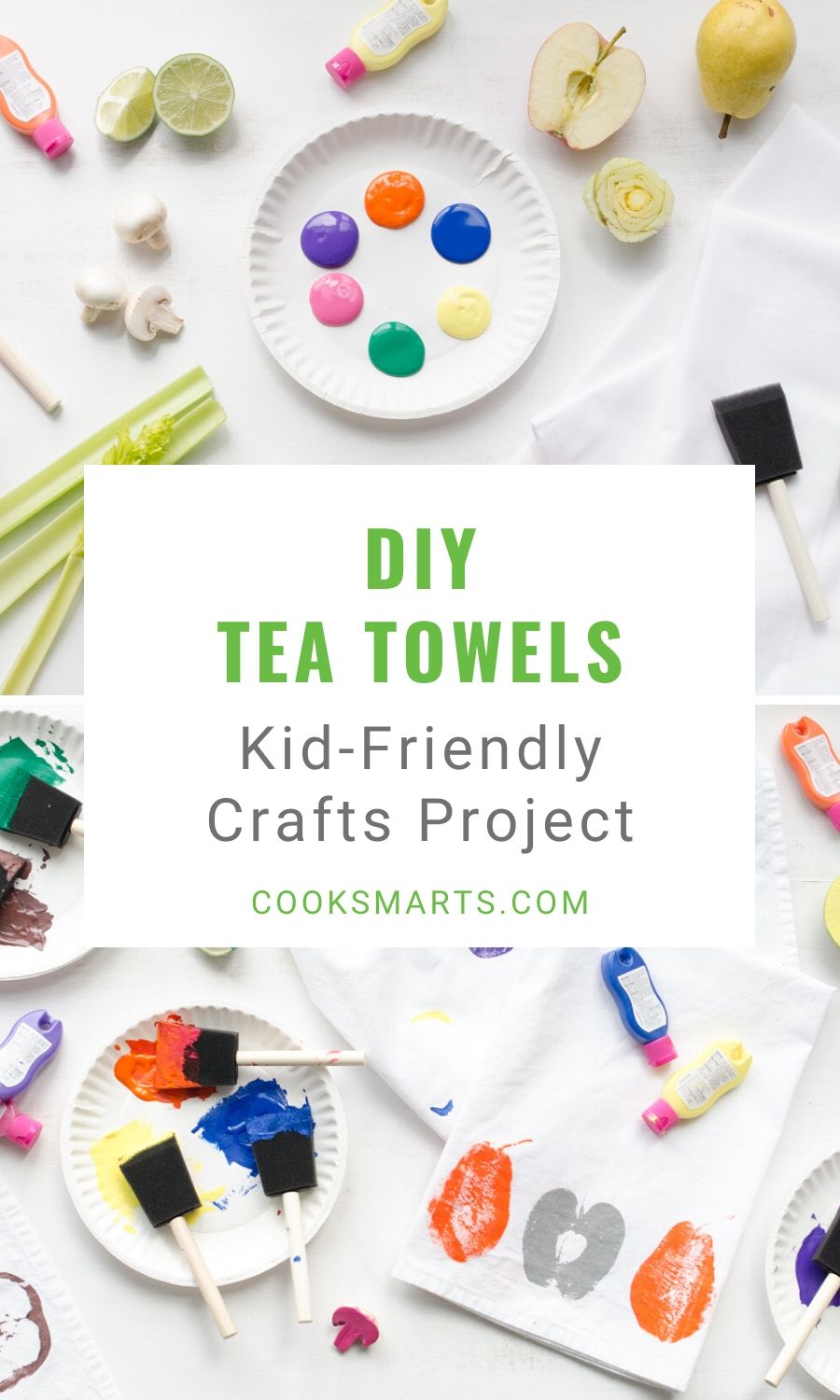How to Make Fruit & Veggie Stamped Tea Towels
Add some meaning and color to your kitchen space with food stamped tea towels made by your kids. This is one summer activity that the whole family can enjoy together, while creating something that is both useful and beautiful!
Kitchen towels are a kitchen essential that often gets overlooked. We tend to remember our knives, our skillets, and other gadgets when we think about ways to cook more efficiently. But all throughout the cooking process, our kitchen towels are there, helping us every step of the way.
Putting a towel under a cutting board prevents it from sliding around when you chop. A towel keeps your station clean, so you can focus on cooking and not messes. Having a towel by your side means you can easily grab things from the oven, especially if you don’t have oven mitts (or they’re too far away at the moment).
So we’re going to give understated kitchen towels some love by throwing it back to an arts and crafts project you most likely did when you were little. Except, now it’s your kids’ turns, and they’re going to leave a colorful mark on your kitchen!
All you need are some fruits and veggies, fabric paint and blank tea towels, and you’ll be able to enjoy a fun, creative activity with your kids.
Before we dive into the directions, let’s go through the materials first.
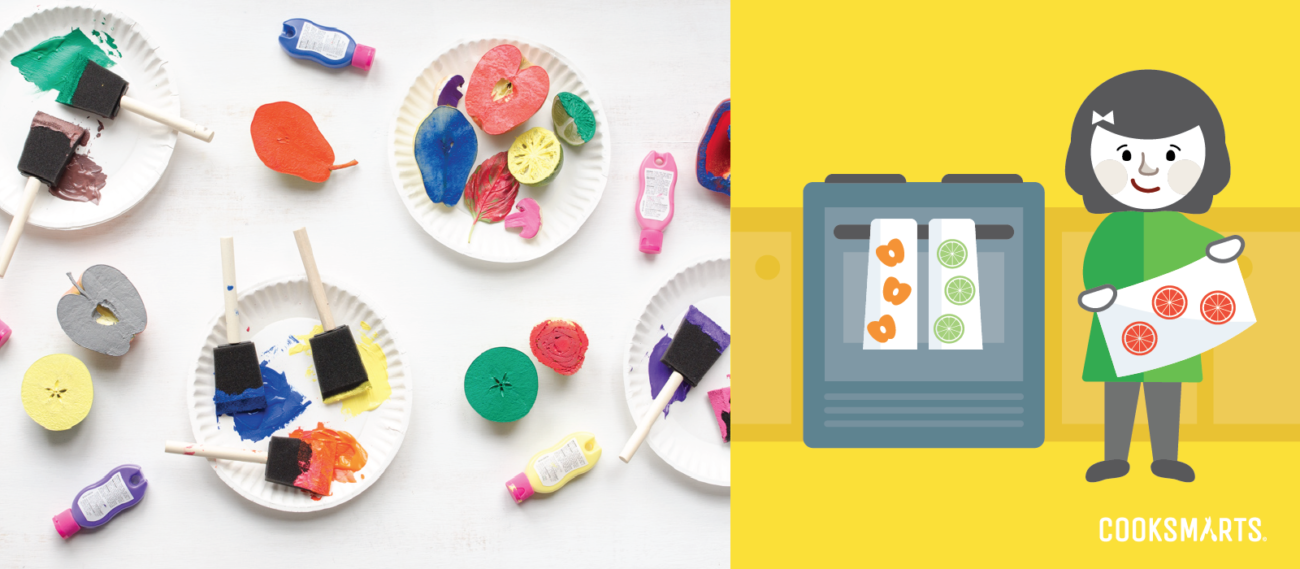
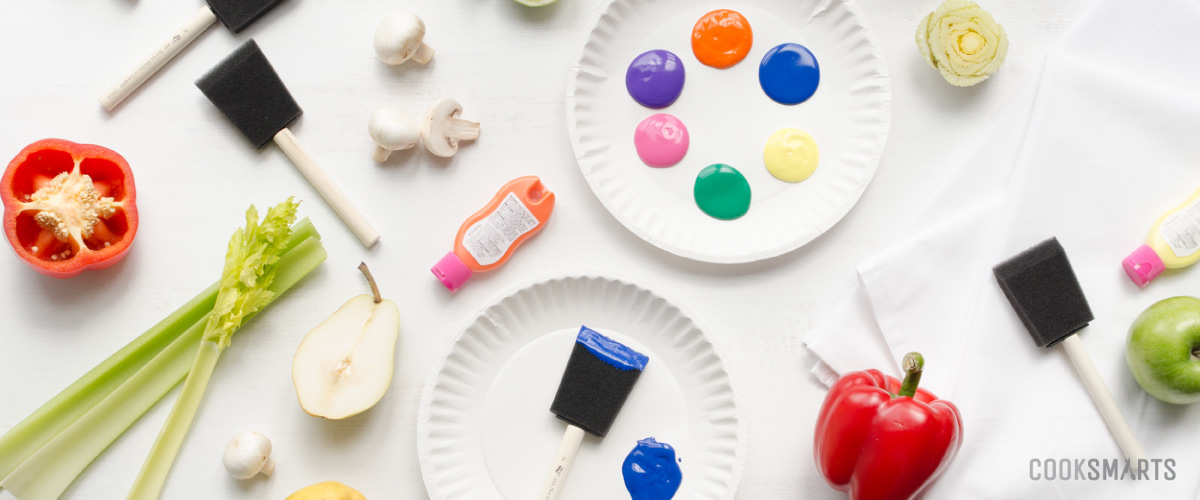
Materials
Tea Towels
You’ll want to get blank, white (or natural) tea towels that have a smooth surface, which will make it easier for your kids to stamp on. A lighter fabric will make the paint colors pop better.
We used these Cotton Craft Flour Sack Kitchen Towels because we wanted more space to stamp, and we liked how they weren’t too thin or thick. Do keep in mind the space you will be using and how many kids will be participating in this craft project. 28” is pretty big, but definitely gives plenty of space for stamping fun!
Fabric Paint
Our tea towels are stamped with this Tulip Soft Fabric Paint Kit. We wanted the option of having a rainbow of colors, which we know kids will love! The only downside is that each bottle is only 1 fluid ounce, and each stamp does require more paint than you’d think. Again, this all depends on how many kids will be stamping and how many towels each kid will make.
Another option is to purchase these Jacquard Textile Colors. You buy each color separately, but this way, you can buy more of one color and get the colors you want for sure.
Foam Brushes
Rather than dip the entire fruit or veggie into the paint directly, it’s best to use these foam brushes. We got the 2” ones, but you can also use 1” ones for smaller veggies or get a multi-size pack. We liked the 2” ones because they covered more surface area more quickly. You can also use any kind of paint brushes you have at home, but depending on the size of the brush, they can take longer to paint.
Paper Plates
These just make it easy to pour fabric paint on and throw away later!
Large Scraps of Paper
If you have scraps of paper (preferably blank) that are going to be recycled, this is a perfect time to give them one last usage. Doing a test run on these paper scraps will let kids practice before they stamp on the real deal. You can even use paper bags from the grocery store. Just cut the sides to open them up and lay flat, so you have lots of practicing space.
Newspaper
Make sure you have a few layers of newspaper protecting your project space. The fabric paint will go through the towels, depending on how much paint is on the stamp. If you don’t have any spare newspaper lying around, extra paper grocery bags will also do the trick.
Iron & Ironing Board
You’ll need these to straighten out the towels after washing them and making them paint-ready, and you’ll need them again at the end to heat set the paint for future washing.
Fruits and Veggies
Now onto the fun part! Certain fruits and veggies are going to be better stamps than others, but that doesn’t mean you can’t experiment. (Just make sure to do a test stamp first!) These are the ones we recommend:
- Celery – Slice off the entire bottom of the celery bunch, and you’ll have a lovely rose-like pattern. In addition, you can use the individual ribs. Remove the leaves from the top, if there are any, and now you have a wide stamp at the bottom of the celery, and a smaller, curved stamp at the top!
- Apple – Halve horizontally as well as vertically for two very different stamps. Make sure to remove the seeds so that they don’t fall out while stamping.
- Pear – Halve horizontally. You can also try leaving the stem on one half and painting it.
- Citrus – Halve lemons, limes, oranges, or grapefruits horizontally to expose the segments. It really helps to carve out some of the flesh in each segment for a cleaner stamp. Quarter the citrus fruit for stamps shaped like wedges. This cut doesn’t need to have any segments carved out before stamping.
- Button Mushrooms – Halve vertically.
- Bell Pepper – Halve horizontally and vertically for two very different stamps!
- Okra – Slice off the stem.
- Fennel – This one is similar to celery, in which you can slice off the entire bottom for a stamp, and use the individual pieces as different stamps.
- Carambola – Also known as starfruit, this would make an awesome star-shaped stamp, if you can find it at the market! Halve horizontally.
Dig through your fridge and see if there are any fruits and veggies you need to use up and add to your stamp pile. For some of the veggies, such as celery and mushrooms, you only need a few pieces, so the rest can be saved for dinner.
Don’t be afraid to get creative! We even tested out the backside of a basil leaf, which was a very messy process indeed, but produced a pretty leaf pattern. This one might be difficult for kids, but just goes to show that experimenting with different stamps can be a fun experiment all on its own.
Tip: Make sure you cut the produce in half (vs smaller pieces) to make it easier for kids to hold and handle the stamp.
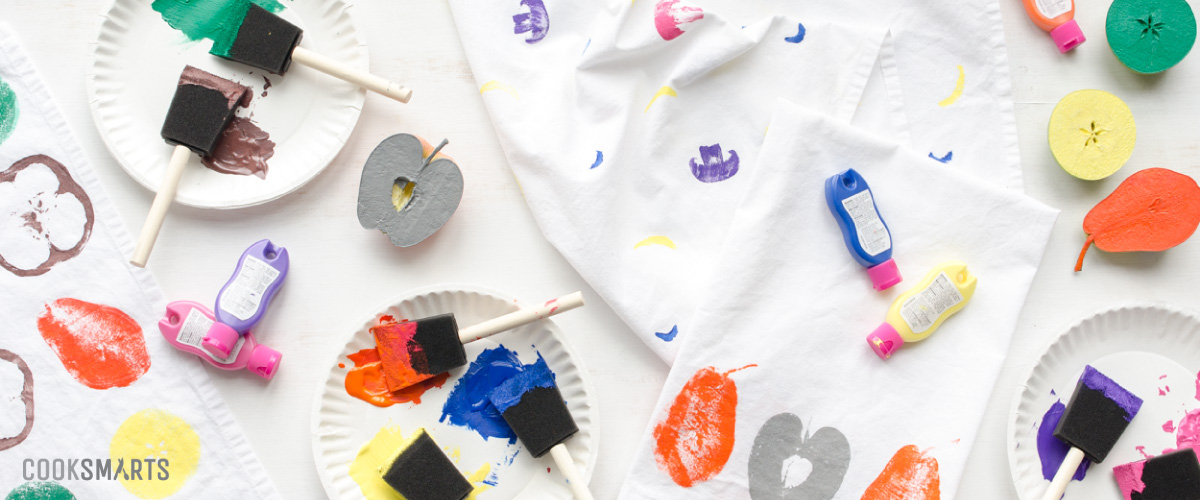
Directions
making fruit & veggie stamped tea towels:
- Adult: Wash and dry tea towels in the laundry. Iron flat.
- Set up activity area by laying newspapers on the table, so that messes will be easier to clean. Chop fruits and veggies, and lay out on the table with tea towels, some paper plates, foam brushes, and scraps of paper.
- Pour fabric paint on paper plates. (Stick to one to two colors per plate.) To make fruit and veggie stamps, take a piece of cut fruit / veggie, dip the foam brush into the paint, and brush the paint all over the cut side of the fruit / veggie.
- Before you stamp the tea towel, test on a scrap of paper first. This will help you figure out if you need more or less paint.
- Decide where you want to stamp the fruit / veggie on the tea towel, then press the fruit / veggie stamp firmly on the tea towel, then slowly remove the fruit / veggie stamp and look at the stamp. If you think it needs more paint, you can paint the same piece of fruit / veggie again and stamp a second layer right on top of the first stamp.
- Repeat until you are done with your pattern!
- Let the paint dry completely before heat setting. We recommended letting it dry for one full day.
Heat Setting the Fabric Paint (for adults):
*This step is necessary if the tea towels are going to be washed.
- Make sure all automatic steam settings are turned off (if your iron has one) and completely empty the water container. You’ll want to use dry heat for this; do not use any steam.
- Set the iron to a medium-hot setting (lower temp if using a more delicate fabric).
- Place a piece of old fabric (or an old, thin dishcloth) on the ironing board. (This piece of fabric will protect your iron cover, just in case any fabric paint gets transferred.) Lay the tea towel with the fabric paint side face down on the old fabric scrap, so that you’ll be ironing the side that is not painted. Alternatively, you can place the piece of old fabric scrap on top of the fabric side of the tea towel and iron right on the old fabric scrap.
- To heat set the fabric paint, you’ll want to iron the painted section of the tea towel for a few minutes, constantly moving the iron to prevent scorching the fabric. It should take between 3 to 5 minutes for the paint to be set.
- Wait at least 4 days before washing the printed tea towels.
We had so much fun making these towels, we probably could have gone the whole day if we didn’t run out of paint!
This project was created as part of our #KidsFood series, where we have come up with ways for kids to get creative and exercise their artistic and investigative skills during the summer. The summer activities we have planned will teach your kids more about food and keep them entertained at the same time.
For more fun food projects to do with your kids, check out these other summertime activities:
How to Make Homemade Play Dough with Food Ingredients
Make homemade play dough with your kids for a fun activity, and give it a twist by using food ingredients… Read more.
What Foods Grow Mold?
We’re calling all little scientists for a food mold experiment! With our fun project, your kids will get a first… Read more.
How Do Plants Absorb Water?
Turn your kids into little scientists and teach them what happens when they water plants! Our fun project will allow… Read more.
We would love to see your kids’ food stamped tea towels, so do share with us on Instagram or Pinterest with hashtag #KidsFood, so we can find them!
Enjoy all the new color additions to your kitchen space!
As always, we’re here to help you live your best life in the kitchen and provide delicious memories for you and your family. Join our cooking community by signing up for our newsletter below, and we’ll send you great cooking tips and resources that will help you raise your kitchen IQ and cook with confidence.



